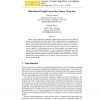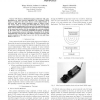ICSE
2009
IEEE-ACM
14 years 1 months ago
2009
IEEE-ACM
Verifying security properties of protocols requires developers to manually create protocol-specific intruder models, which could be tedious and error prone. We present Slede, a ve...
IAT
2010
IEEE
14 years 1 months ago
2010
IEEE
As wireless sensor network applications grow in complexity, ad-hoc techniques are no longer adequate. Thus, it is crucial that these systems be adaptive and autonomous to remain f...
CORR
2007
Springer
14 years 3 months ago
2007
Springer
– Redundant sensing capabilities are often required in sensor network applications due to various reasons, e.g. robustness, fault tolerance, or increased accuracy. At the same ti...
ISCAPDCS
2007
14 years 5 months ago
2007
The coverage problem is of great interest for many sensor network applications, for example, detection of intruders in the sensor field. Topological changes in sensor networks ma...
DCOSS
2010
Springer
14 years 7 months ago
2010
Springer
This paper presents the uDSSP ("micro DSSP") programming model which simplifies the development of distributed sensor network applications that make use of complex in-net...
MOBIHOC
2000
ACM
14 years 7 months ago
2000
ACM
AbstractDeveloping wireless sensor networks can enable information gathering, information processing and reliable monitoring of a variety of environments for both civil and militar...
GD
2004
Springer
14 years 9 months ago
2004
Springer
Sensor network applications frequently require that the sensors know their physical locations in some global coordinate system. This is usually achieved by equipping each sensor w...
SIGOPSE
2004
ACM
14 years 9 months ago
2004
ACM
Wireless ad hoc networks of sensor nodes are envisioned to be deployed in the physical environment to monitor a wide variety of real-world phenomena. Almost any sensor network appl...
SENSYS
2004
ACM
14 years 9 months ago
2004
ACM
We propose B-MAC, a carrier sense media access protocol for wireless sensor networks that provides a flexible interface to obtain ultra low power operation, effective collision a...
ISCAS
2005
IEEE
14 years 9 months ago
2005
IEEE
— We discuss a distributed imaging architecture with active illumination for sensor network applications. An event-based CMOS imager is employed at the sensor level, to convert l...




